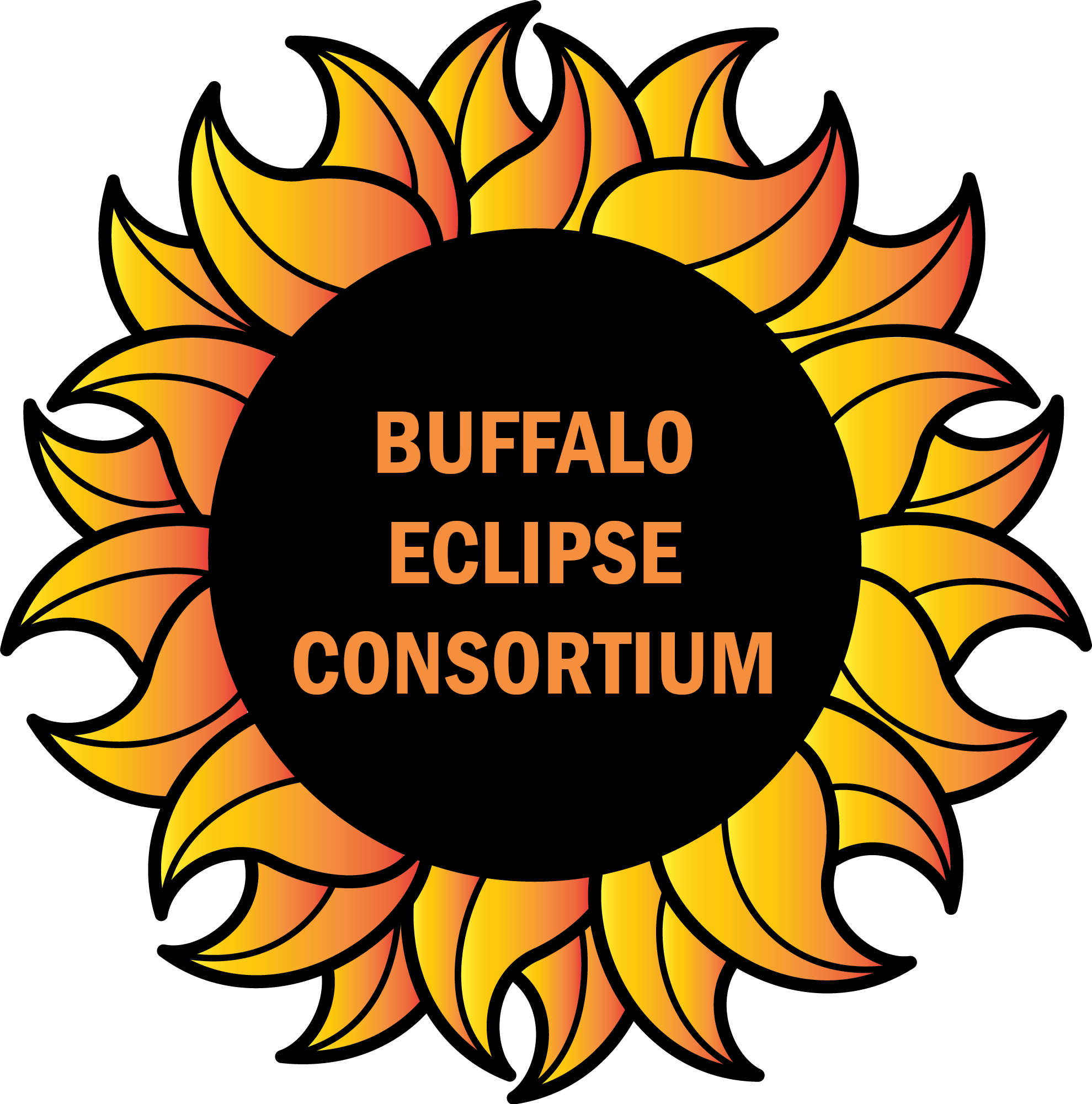Big thanks to the Rochester Museum and Science Center / Strasenburgh Planetarium for the FAQs below!
The Moon will begin to cover the Sun at 2:04 pm. Using a safe solar viewing method, we will see more and more of the Sun covered by the Moon over the next 70 minutes. This time is called a partial phase because the Sun is partially covered by the Moon. Totality begins at approximately 3:15pm and lasts about 3 minutes 45 seconds for viewers on the centerline. The farther you are from the centerline, the shorter totality will last. After totality, the Moon gradually uncovers the Sun in a second partial phase. The eclipse ends for Buffalo viewers at about 4:30 pm. A total eclipse is one of the rarest and most spectacular events in nature. During the partial phases just before and after totality, the landscape around you is transformed by eerie dim light and strangely sharp shadows. During totality, the sky becomes as dark as deep twilight, bright stars and planets appear, and the Sun’s outer atmosphere, called the corona, shines around the black disk of the Moon’s silhouette. Changes in temperature, winds, and animal behavior occur during the time around totality. The experience is emotionally powerful and unforgettable. The Moon always casts a long shadow into space. Sometimes, as the Moon goes around Earth, that shadow sweeps over Earth. That causes an eclipse as seen by viewers on Earth. The Moon’s shadow has a dark inner part, called the umbra, and a larger, fainter outer part, the penumbra. As seen from space, the shadow on Earth appears as a small black spot (the umbra) surrounded by a large gray blob (the penumbra). Any Earth-based viewer who is in the umbra sees the Sun totally eclipsed; viewers in the penumbra see the Sun partially eclipsed. Like hiking in the woods, riding a bicycle, or cooking on an outdoor grill, eclipse viewing is safe, enjoyable, and worthwhile if you equip yourself with some basic information and take simple precautions. To prevent eye damage, do not look directly at the Sun during the partial phases of an eclipse. (You wouldn’t normally do that anyway, but during an eclipse, the Sun is more interesting than usual.) Don’t look into a mirror at a reflected image of the Sun. Instead, look through a filter or “glasses” made specifically for solar viewing, or project the Sun’s image onto some surface. It IS safe to look directly at the Sun without viewing equipment during the brief time of totality. There are no such things as dangerous rays that come only during eclipses. This eclipse will be total as seen from a 110-mile-wide path of totality extending from Mazatlan & Durango in Mexico through Dallas, TX, Cleveland, OH, Buffalo, Rochester, Watertown & Plattsburgh in NY, northern Maine and parts of the Montreal area & New Brunswick in Canada. Good question! As you make your plans, be sure that you will have a clear line of sight with no trees or buildings in the way. As seen from Western New York at mid-eclipse, the sun will be in the southwestern sky, a little more than halfway up from the horizon to the overhead point. More precisely, the sun will be at an altitude of 45° and an azimuth (heading) of 226°. For Buffalo or any other single location, it is rare; globally, it is not so rare. There are at least two solar eclipses every year, and there can be as many as five. In many eclipses, the Moon’s shadow passes over the oceans or polar regions, where few people are watching. For most of the others, the Moon’s shadow does not come near Buffalo. Jean Meeus, a world-renowned expert on astronomical calculations, found that a random point on Earth sees either a total or annular eclipse on average every 140 years. But that is only an average. The actual timing of eclipses at one location is irregular. For example, Carbondale, Illinois is about to experience two total eclipses just seven years apart (2017 and 2024), then not another one until the twenty-fourth century! Use this interactive map to find your exact times for the eclipse. The closer you are to the centerline of the path of totality, the longer totality will last for you. Because there is so much to see and feel during totality, it is worthwhile to travel to a place with a few seconds more. If you are outside the path of totality, you will not get the experience of a total eclipse. A partial eclipse is not the same experience at all. We suggest you make plans to travel to the path of totality. No one who has experienced a total eclipse regrets the effort. WHAT WILL WE SEE FROM BUFFALO?
WHAT IS THE BIG DEAL?
What’s up with shadows, umbra, preumbra, etc?
ARE SOLAR ECLIPSES DANGEROUS?
Where else in the US will totality be visible?
Where in the sky will the sun be at eclipse time?
HOW RARE IS THIS?
I don’t live in the city of Buffalo, but I’m in the area. What will the timing of the Solar Eclipse be for me?
